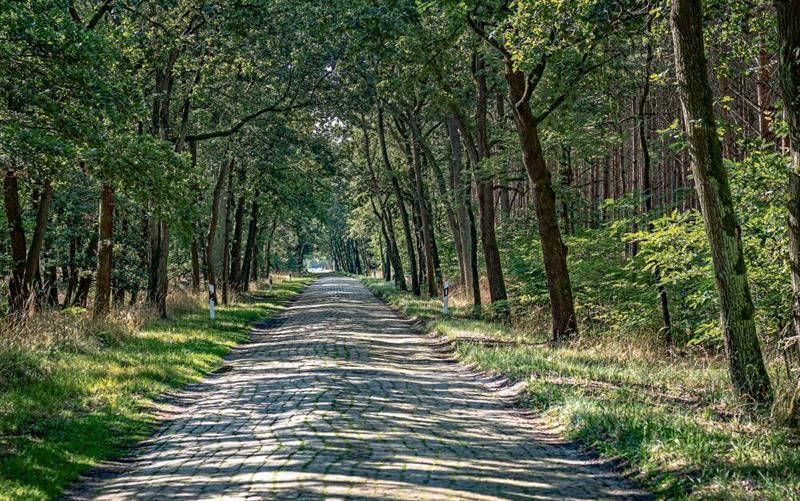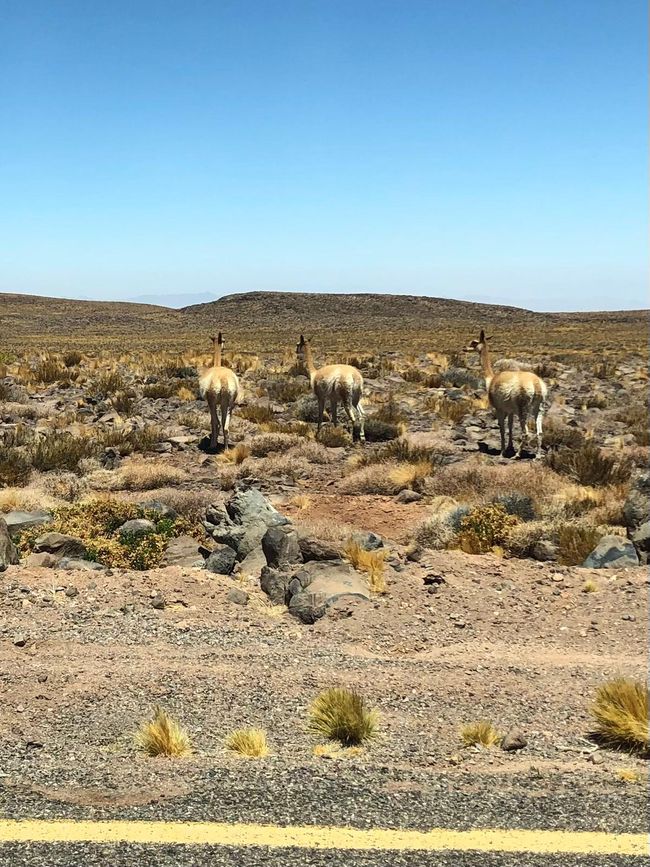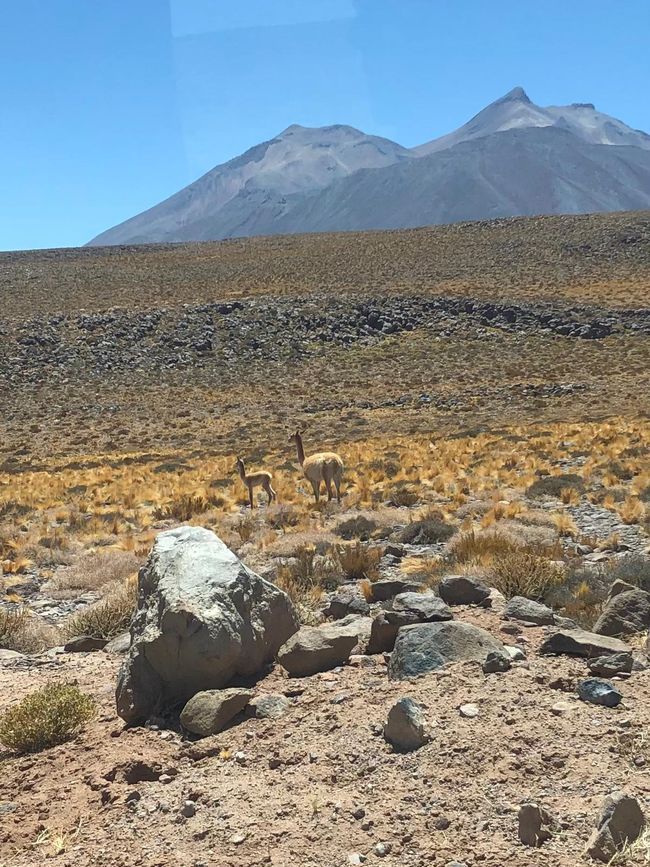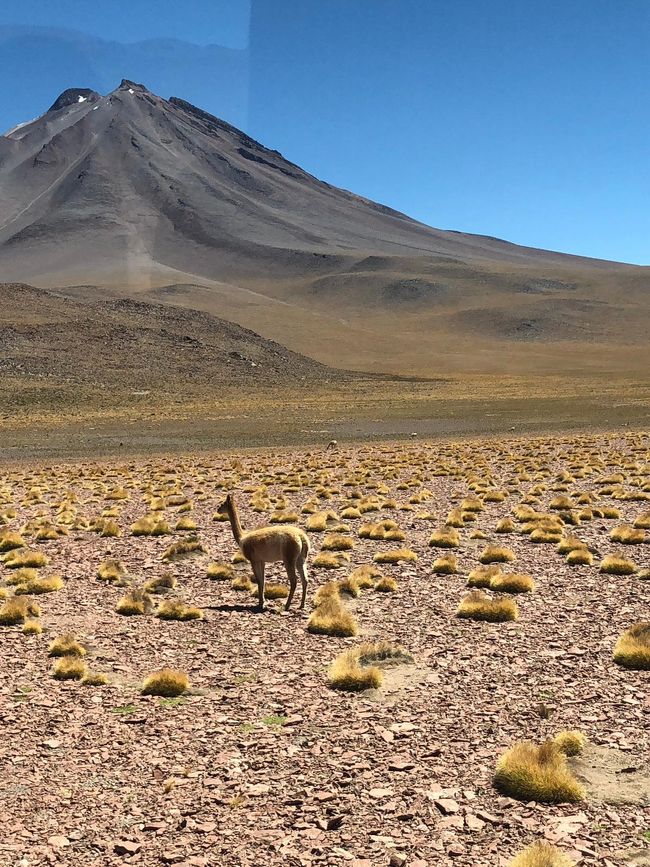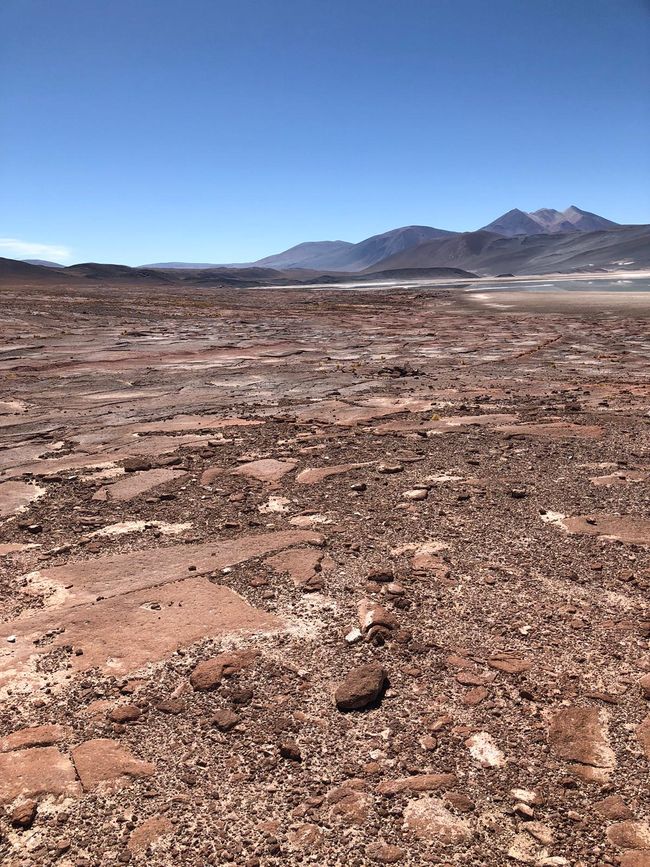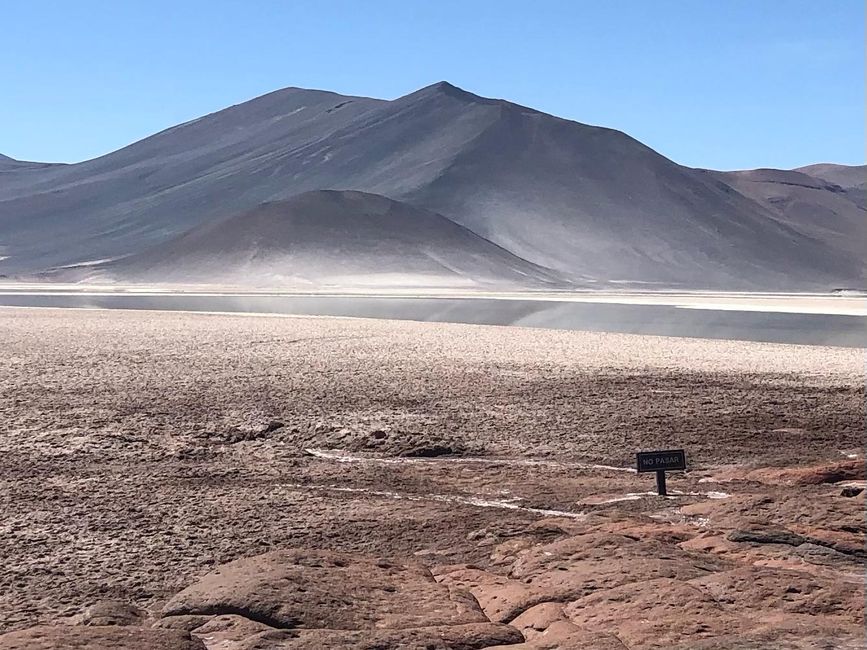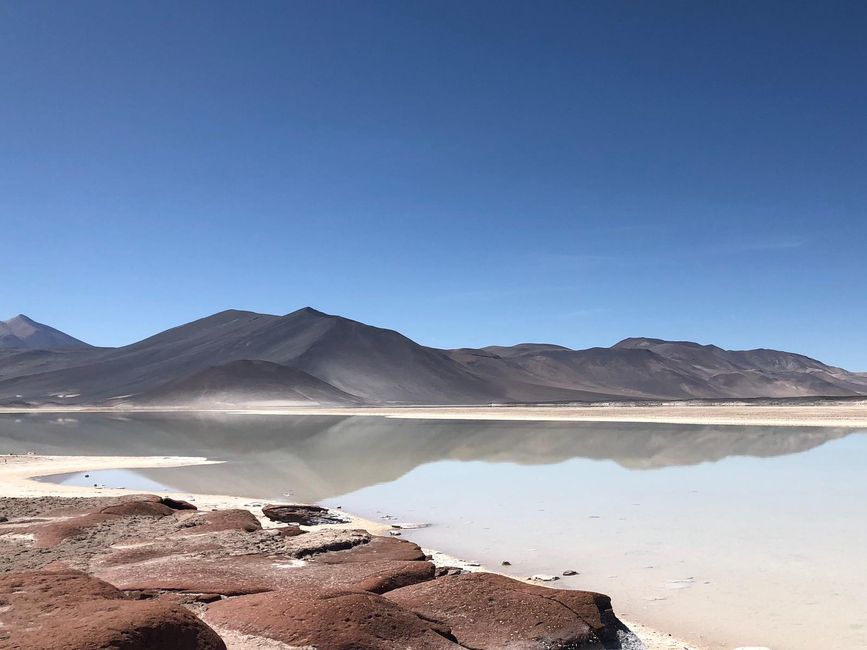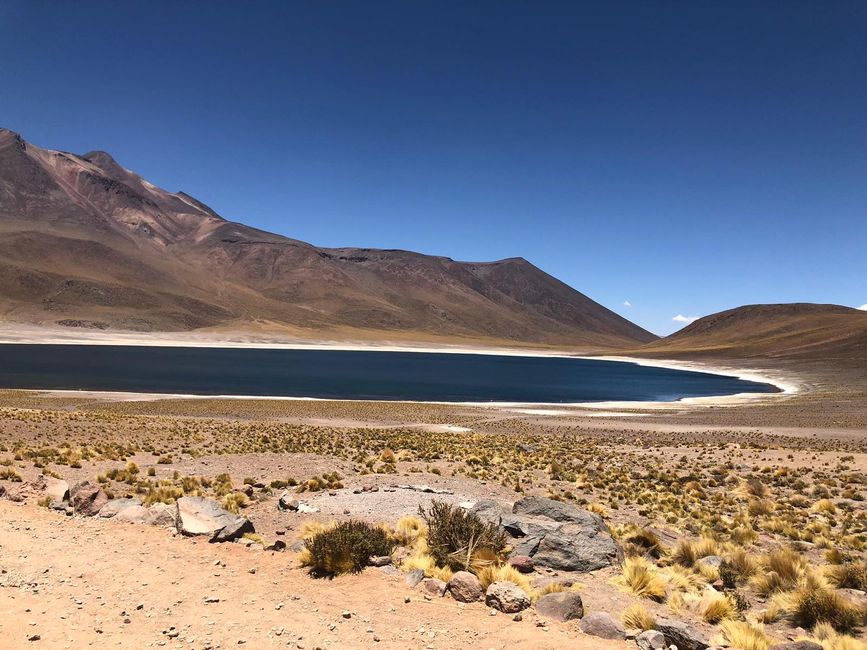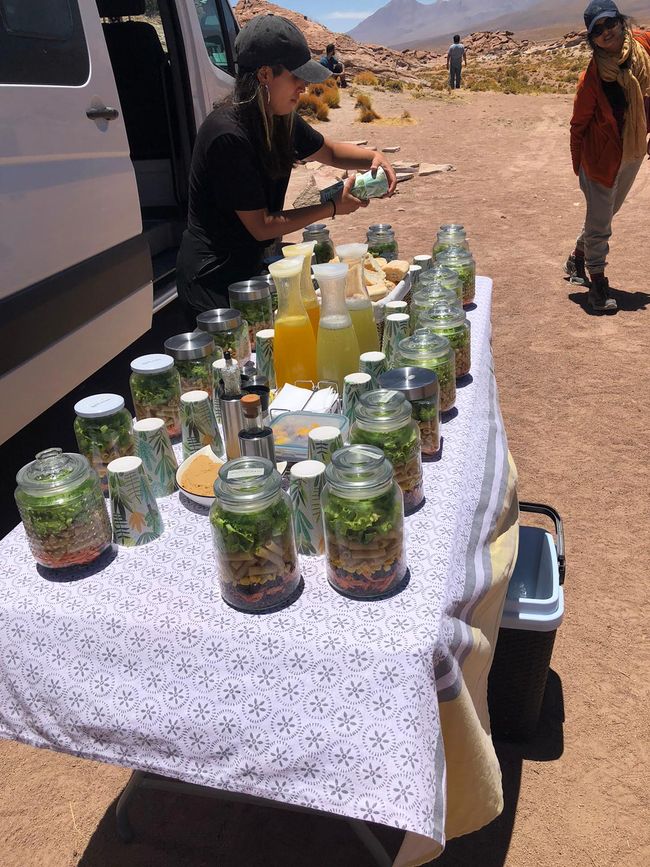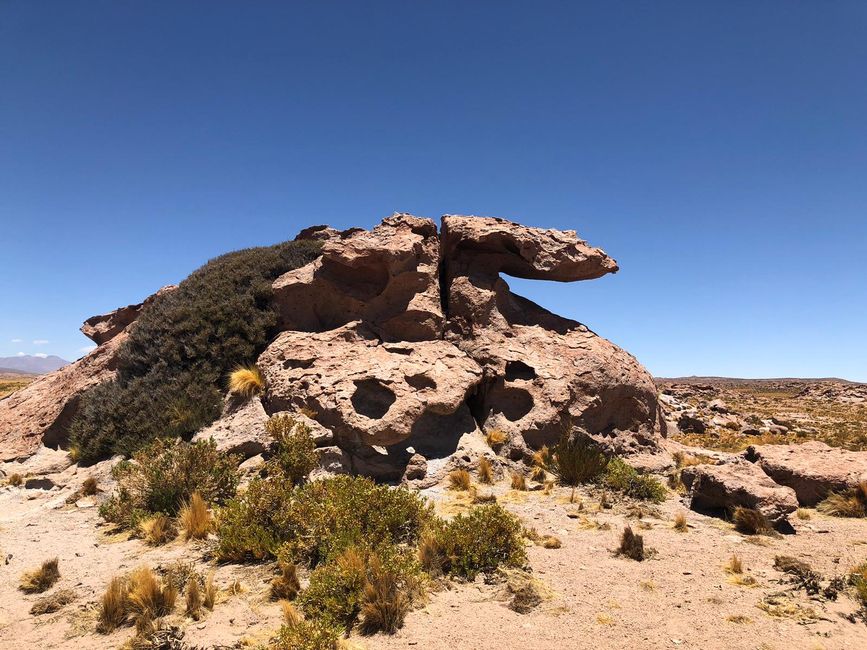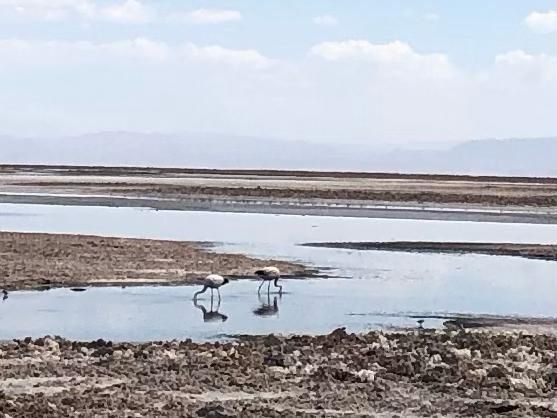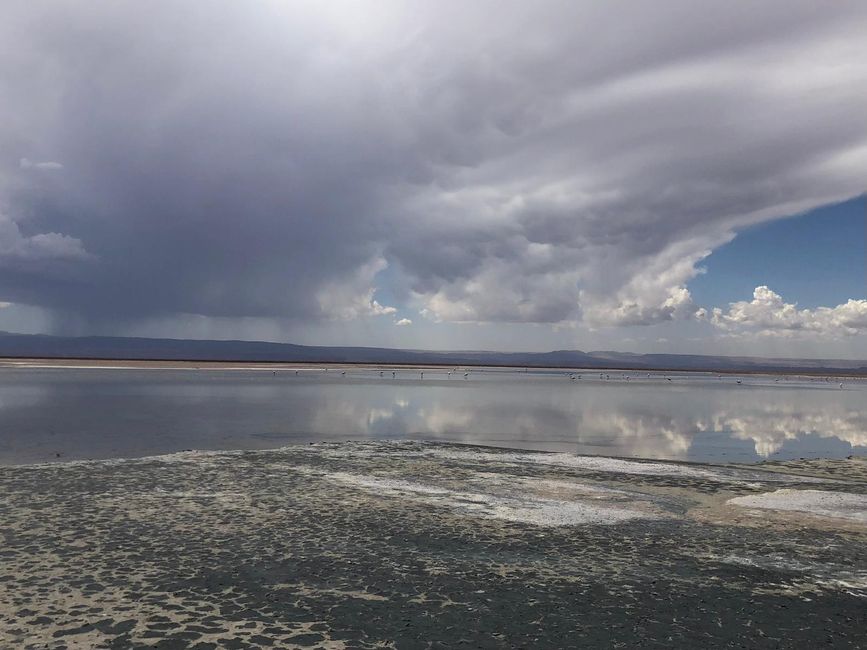SAN PEDRO DE ATACAMA 24.01.2023
Ipapashiwe: 03.02.2023
Bhalisela kwincwadana
Today we took a full-day tour to Piedras Rojas Rochas (red rocks), Lagunas Antiplanicas, and Chaxa. During this excursion, we were supposed to reach a maximum altitude of 4200 m! When you consider that the Zugspitze (the highest mountain in Germany) is around 2930 meters high and the Mont Blanc (the highest mountain in Europe) is around 5400 meters high, everything becomes relative. Alone in Chile, there are said to be over 30 active volcanoes, the highest of which reaches about 6700 m!
But first, we were in San Pedro at the normal altitude of about 2300 meters and had to get up very early again (6 am). And again, our ingrained mentality: be punctual, have everything packed and ready outside the door, and don't make the bus wait for the other tour participants. Although this excursion started differently this time: as a reminder, in San Pedro, there are a huge number of small and larger tour offices (according to the Lonely Planet, there were around 65 in 2017!), all of which offer more or less the same tours. These offices sell the tours, but usually do not conduct them themselves, but instead pass the customers on to other companies that are responsible for the execution. And it is possible to encounter very different companies. We have seen beat-up buses and the newest Mercedes Sprinter vans. Buses with completely worn out tires and buses with fresh twin tires. There are tour buses where the driver is also the guide, and there are tours that are supervised by two people. So we were lucky to have an optimal logistical experience on all our excursions in San Pedro. Maybe also because the brother of Franziska's colleague in Santiago works in the office where we booked everything. And if we had to pay around 500€ for everything, then we can expect something decent!
But the bus didn't arrive this morning for some reason! All the participants, including us (Franziska's Chilean cell phone!), were there. The wait, dark and cool, was shortened by the comments and questions of the other passengers. And besides, everyone could track on Google where the bus was and who it was picking up. But we had problems, because it constantly drove near us but couldn't find us. Eventually, we received a call and Karin had to provide the address again via WhatsApp. Finally, around 6:40 am, we were able to take our seats in the van and shortly afterwards we were once again behind many other tour vehicles for bread pickup. The last couple, in any case, boarded with an hour's delay and were "not amused"! Then we finally set off! We drove for about an hour towards the Minikes volcano (6400 m) and then had our breakfast stop right next to the road. Not just the usual, but with freshly prepared scrambled eggs, fresh avocado cream, plenty of fruit, and a selection of sweet pastries. Really delicious, especially since the road next to us hardly disturbed us, as it was almost empty. Only other tour buses parked next to us, and a completely shy desert fox (please do not feed, we were told!) was also present. The volcano and its constantly changing appearance were a favorite topic of our guide. But she was also right because when we approached from one side, it looked like a relatively flat stratovolcano, and when we changed our direction of travel, it looked like Mount Vesuvius. There were still individual snowfields under the lava-black peak, releasing meltwater through narrow paths. Now the road was constantly uphill and the frequently changing colors of the ground cover made the cell phones click, but it is very difficult (actually impossible!?) to capture it in pictures. Once bone-dry reddish-brown dusty plains and then greenish-yellow grooves, but they are not densely overgrown either! All of this against the backdrop of reddish-looking rock formations! Finally, we reached the Pedro rochas, of course, with cash entry (reduced for retirees!), and then a 2 km long footpath. The guide specifically asked us if we could handle the altitude (4100 m) and if we would show any allergic reactions. We were supposed to walk slowly and take our time. With some steps, unlike Karin, I already had a strange feeling (like slight dizziness!) and consciously walked slowly. But no one in the group of twelve had constant headaches or respiratory distress. In addition to the two of us, there were three somewhat older gentlemen and the rest were young people from all over the world. So we came to another lagoon, with a partially solid crust surface and a white salt rim. This lagoon was bordered on the visitor side by red rocks, hence the name. The surface of the rocks looked more like a very wide Roman road, composed of very large stones. A couple from our group insisted on going to the edge, but they were massively called back by the ranger staff. In general, there are supervisors at all tourist spots in the national parks who act confidently. Even though they have to be on duty all day at these temperatures.
So also at the next stop, a long fresh-water lake below the volcano. It has always had a sacred meaning for the locals, but it was also used for swimming by tourists. But when a kite surfer with his board surfed across the lake in 2018, all tourist activities were prohibited. Now there is only a designated path from which photos can be taken. And you can't get closer to the few flamingos that live here. The second part of this water, which is connected underground, was now at 4200 m! Here too, there was a breathtaking view of the volcano, the water, and the animals (guanacos, flamingos, seabirds).
However, flamingos were shown to us very close to the next stop. Again, entry in cash for retirees, and then through a small newly built ranger station to the salt lake behind it. There were all three types of flamingos found in Chile. I have forgotten their names, but I know that they are distinguished by the colors of their feathers (black and white, light with a bit of pink, completely white). So they are not comparable to the pink one-legged birds in our zoo. We learned that such a flamingo has to eat a whole lot (1 kg) of tiny organisms in the water and therefore keeps its head underwater permanently! But the true heroes of the lake were small inconspicuous birds that fly non-stop from here to Canada once a year, have their honeymoon there, and then return. Our guide's pride!
And she was also happy to present us with lunch on the way back. We had thought that we would all go to a restaurant together, but the bus left the road and parked about 200 meters away in a beautiful area with rugged rock formations and shrubs. Needless to say, our white bus wasn't the only one parked there. Then the camping table was unfolded, and various fruit juices with bread were placed on the table. Each person received a drinking cup, a set of cutlery, and a filled glass. So the size and shape of a glass jar, filled at the bottom with fried pieces of chicken meat, a layer of noodles on top, and a salad layer of green lettuce and red beets. Close the glass with the lid and done. Lemon, oil, and salt for marinating were on the table. So everyone found a seat in the area and ate their jar with a fork and spoon. That was something completely new! Not only for us because when we asked, we were told that there is a catering company specifically for these excursions! Not a small adobe village in the middle of the Atacama!
Satisfied and full, we headed back, and we even managed the short walk to the Airbnb. But then that was enough, and a cold drink with a cigarette in the porch swing ended this exhausting day. We were glad that we had divided our four tours from the beginning: half-day tour in the afternoon to get to know the area, half-day tour in the morning with an early wake-up, full-day tour with even less sleep, and then a day of rest before going to the highest point (geysers) with a 4 am wake-up call.
Bhalisela kwincwadana
Phendula
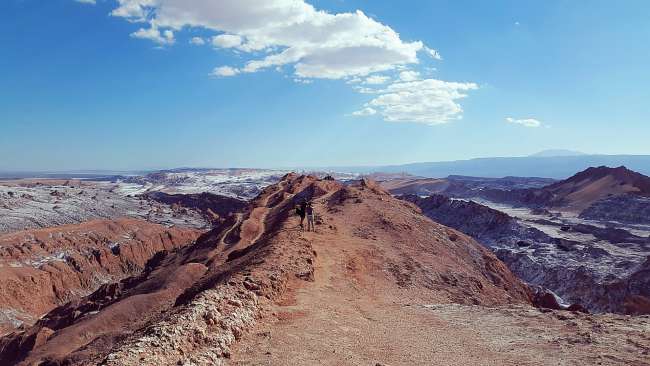
Iingxelo zohambo Tshile
